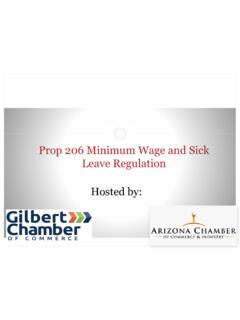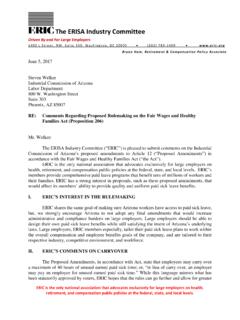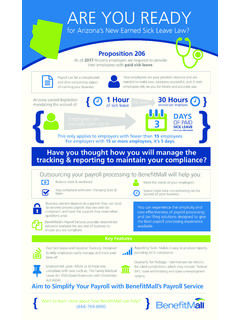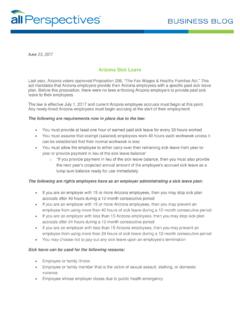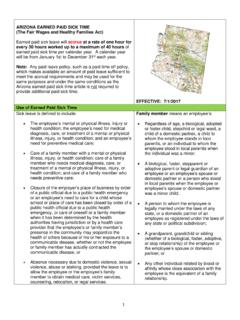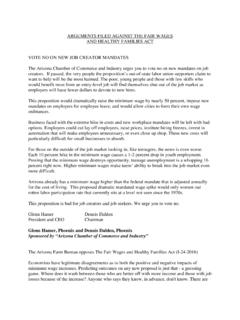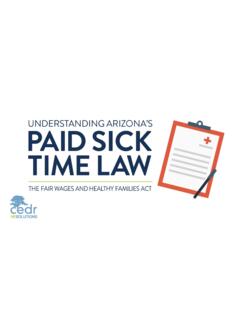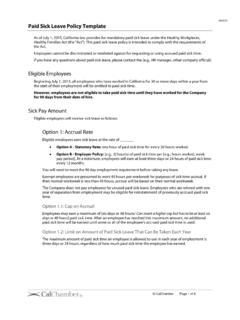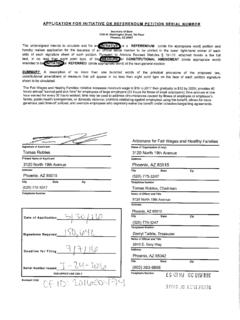Transcription of Industrial Commission of Arizona Issues Long-Awaited ...
1 During the November 2016 election, Arizona voters were presented with an initiative (Prop. 206: the Fair Wages and Healthy Families Act ) that would raise the state minimum wage and require that all Arizona employers begin to make paid sick leave available to employees. The initiative passed by a healthy margin and was codified at 23-371 et seq. After a series of court challenges regarding the constitutionality of the initiative, the first part of the law went into effect on January 1, 2017. That part of the law raised the state minimum wage to US$10/hour, and additional increases will go into effect in future years. The balance of the law requires that employers make sick leave available to their employees beginning on July 1, 2017.
2 The paid sick leave requirements of the law require businesses with 14 or fewer employees to provide employees with at least 24 hours of leave annually, and businesses with 15 or more employees to provide employees with at least 40 hours of leave annually, which can be used for any of four covered reasons:1. An employee s own mental or physical illness, injury, or health condition; need for medical diagnosis, care, or treatment of a mental or physical illness, injury or health condition; or need for preventive medical An employee s need to care for a sick or injured family member or one needing preventive Business closures due to public health emergencies or absences occasioned by exposure to communicable An employee s absence to address specific needs resulting from domestic violence, sexual violence, abuse or to the new law, paid sick leave must accrue at a rate of at least one hour for every 30 hours worked by an employee.
3 Full-time, part-time, seasonal and temporary employees are all entitled to accrue paid sick leave . Employers may cap annual accrual at 24 or 40 hours, depending on their size, and may also limit annual use by employees to 24 or 40 hours, as applicable. The new law requires that unused, accrued paid sick leave be paid out at year end at its equivalent hourly rate and a new paid sick leave bank of 24 or 40 hours, as applicable, be made immediately available to employees at the start of the next year. Alternatively, employers can rollover unused, accrued paid sick leave to the following year. Except as just described, employers need not pay out unused, accrued paid sick leave upon termination, resignation, retirement, or other separation from new law requires that employers provide notice of the statute and its protections to employees.
4 It also incorporates a rebuttable presumption of prohibited and actionable retaliation when any employee is terminated or otherwise suffers an adverse employment action within 90 days of taking protected time off. Not surprisingly, the initiative left open a number of unanswered questions for employers, particularly regarding the accrual method, carryover option, and rebuttable presumption of retaliation, and we hoped these would be addressed via regulation. According to 23-376, the initiative authorized the Industrial Commission of Arizona to coordinate implementation and enforcement of the law and to promulgate appropriate guidelines or regulations for such purposes.
5 On May 10, 2017, over six months after the election, the Industrial Commission submitted a Notice of Proposed Rulemaking to the Arizona Secretary of State. According to a press release issued the same day, the Proposed Rules are intended to clearly outline the new law and ease the burden of businesses implementing these new rules. Interested parties have until June 5, 2017 to submit comments on the proposed rules before they become final. (Comments can be submitted in person, by letter, by telephone or fax, or most easily, via e-mail to The proposed rules, while not final, clarify the state s thinking on a few open questions regarding the paid sick leave statute: According to the statute, at year-end, unused accrued paid sick time must be either paid out to employees at their regular rate of pay (and a new bank of 24 or 40 hours, depending on the employer s size, must be made available for immediate use the next year), or those accrued hours must be rolled over to the following year.)
6 Although employers can set a cap on annual accrual and annual use of paid sick leave , the rollover option when coupled with subsequent accrual could result in employees accruing more hours than they are permitted to use in a single year, a situation that many feared could snowball over time. The proposed rules make clear that the carryover requirement maxes out at 24 or 40 hours, as applicable, so employees will not be carrying forward hours well in excess of that limit. But the proposed rules also provide that the carryover shall not affect under the Act, meaning that even if an employee rolls over 24 or 40 hours, he or she must continue to accrue additional time off, even if the employee is limited to using only 24 or 40 hours in a single Commission of Arizona Issues Long-Awaited Proposed Rulemaking Regarding Arizona s paid sick leave Statute All employees are entitled to paid sick leave , including those paid on a Commission basis, tipped employees and those who work at multiple hourly rates.
7 Many employers questioned what the monetary equivalent of an hour of paid sick leave would be for such employees. The proposed rules establish a series of calculation methods: Employees paid a regular hourly rate should be paid their regular hourly rate for time taken as paid sick leave . Salaried employees should be paid an hourly rate calculated by dividing the employee s total wages earned during the pay period (not defined) by the number of hours agreed to be worked in the pay period (with exempt employees using a presumed 40-hour workweek unless they ve agreed with their employer to a shorter standard schedule). Employees paid multiple hourly rates of pay should be paid either: - The wages they would have been paid , if known, for the period of time in which sick time is used, or, if that cannot be determined - The weighted average of all hourly rates of pay during the previous pay period (again, the phrase is undefined) For employees paid on a Commission , piece-rate, or fee-for-service basis, their hourly rate shall be determined in the following order of priority.
8 - The established hourly rate - The wages the employee would have been paid for the period of time in which earned paid sick time is used - A reasonable estimation of the wages that the employee would have been paid for the period of time in which the earned paid sick time is used - The weighted average of all hourly rates of pay during the previous 90 days, if the employee worked regularly during the previous 90-day period The hourly rate does not include additions to an employee s base rate for overtime or holiday pay, bonuses, other types of incentive pay, tips, or gifts. It does, however, include shift differentials, hazard pay and similar premiums, and must always meet or exceed the statutory minimum wage (US$10/hour as of Jan.)
9 1, 2017). In addition to retaining payroll records, employers must begin to preserve payroll or other records of earned paid sick time accrued and used each pay period, by employee, along with each employee s current earned paid sick time balance. Small businesses ( , those with less than US$500,000 in gross annual revenue) must comply with all aspects of the law except that they need not post the otherwise-required notice about employees rights under the statute. The exemption is to the notice posting obligation only; small businesses still must provide paid sick leave to their employees beginning July 1. The proposed rules unfortunately do not answer a question frequently raised by employers as to whether paid sick leave accrual can be prorated for July 1-December 31, 2017.
10 Employers are thus advised to proceed with caution if they choose to award sick leave in a lump sum instead of relying on the statute s accrual method ( , one hour of paid sick leave for every 30 hours worked by the employee). The proposed rules also conflate important terminology. For example, employees are entitled to payment of the same hourly rate that he or she would have earn[ed] for the workweek in which the employee uses earned paid sick time and which is no less than minimum wage. Proposed R20-5-1202(19). In attempting to clarify this language, however, the proposed rules then refer to salary payments in preceding pay periods, not workweeks. This leaves some confusion still regarding the appropriate increment of time to consider when determining the compensation due an employee paid other than on an hourly , the proposed rules provide no additional guidance on the anti-retaliation provisions of the statute, or the rebuttable presumption set forth in the statute that any adverse action taken within 90 days of an absence covered by the statute is retaliatory.






